List of Contents
Transcranial Magnetic Stimulation System Market Size and Forecast 2025 to 2034
The global transcranial magnetic stimulation system market size accounted for USD 1.38 billion in 2024 and is predicted to increase from USD 1.51 billion in 2025 to approximately USD 3.33 billion by 2034, expanding at a CAGR of 9.22% from 2025 to 2034.The growth of the market is attributed to the rising prevalence of depression and neurological disorders, along with increasing demand for non-invasive and drug-free treatment options.
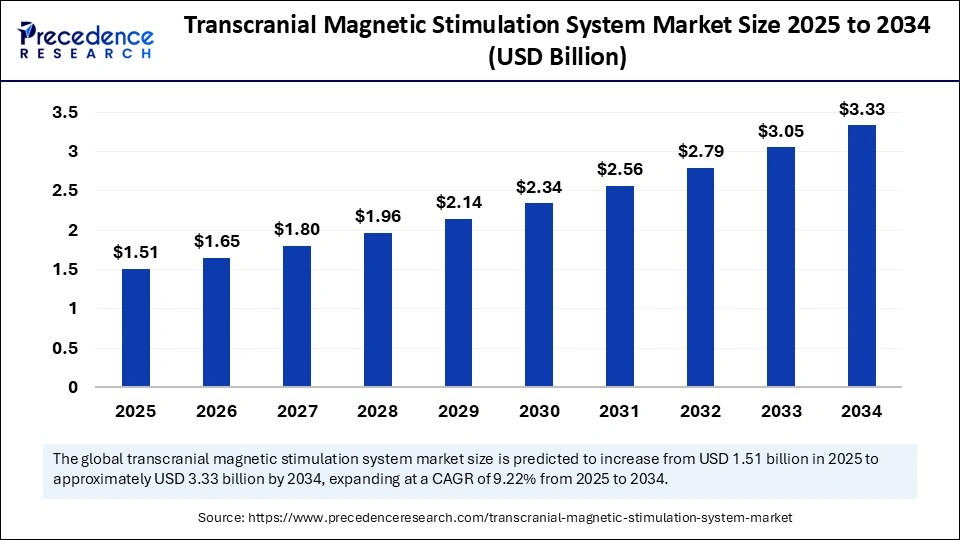
Transcranial Magnetic Stimulation System MarketKey Takeaways
- In terms of revenue, the transcranial magnetic stimulation system market is valued at $1.51 billion in 2025.
- It is projected to reach $3.33 billion by 2034.
- The market is expected to grow at a CAGR of 9.22% from 2025 to 2034.
- North America accounted for the largest revenue share of 33% in 2024.
- Asia Pacific is expected to expand at the fastest CAGR of 10.3% during the forecast period.
- By type, the repetitive transcranial magnetic stimulation segment held the biggest revenue share of 40% in 2024.
- By type, the deep transcranial magnetic stimulation segment is expected to grow at the fastest CAGR of 9.64% in the coming years.
- By application, the Alzheimer's disease segment contributed the largest revenue share of 43% in 2024.
- By application, the depression segment is expected to grow at the fastest CAGR in the upcoming period.
- By age group, the adults segment held the major revenue share of 60% in 2024.
- By age group, the children segment is expected to grow at a significant CAGR of 9.52% from 2025 to 2034.
How is Artificial Intelligence Enhancing the Precision and Personalization of Transcranial Magnetic Stimulation (TMS) Therapy?
As TMS therapy becomes more precise and individualized, Artificial Intelligence is revolutionizing the field. Historically, TMS treatments used generalized stimulation protocols that used Anatomical landmarks to target the left dorsolateral prefrontal cortex (DLPFC). Each patient's unique neutral network is mapped out using individual brain imaging such as fMRI and EEG. This guarantees that the precise region most likely to produce a therapeutic response receives stimulation, improving results and lowering nonresponse rates. To adjust the location frequency, timing, and intensity of stimulation, artificial intelligence (AI) algorithms can examine vast datasets of previous patient responses.
These individualized procedures change over time in response to neurobiological shifts and continuous patient feedback. Particularly for depression and anxiety that are resistant to treatment, this results in reduced side effects, shorter treatment durations, and increased efficacy. By automatically modifying coil placements or stimulation patterns in response to patient feedback or biomarker readings, AI also helps with real-time treatment monitoring. For instance, BrainsWay latest AI-powered analytics for its Deep TMS platform is enhancing personalization for patients with depression and OCD. This tool analyzes patient responses and suggests protocol modifications.
U.S. Transcranial Magnetic Stimulation System Market Size and Growth 2025 to 2034
The U.S. transcranial magnetic stimulation system market size was exhibited at USD 387.09 million in 2024 and is projected to be worth around USD 953.80 million n by 2034, growing at a CAGR of 9.43% from 2025 to 2034.
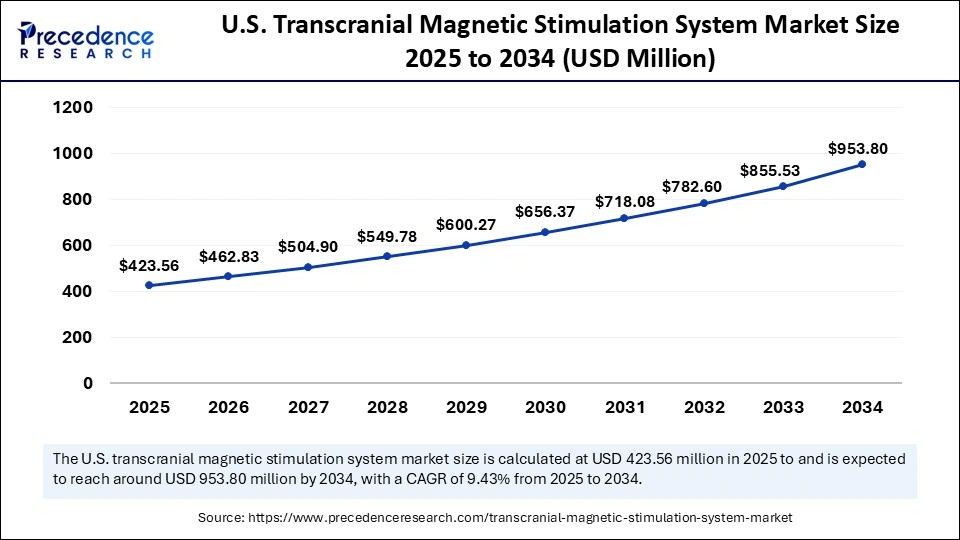
What made North America the dominant region in the transcranial magnetic stimulation system market?
North America registered dominance in the market by holding the largest revenue share of 33% in 2024. This is mainly due to its sophisticated healthcare system, large R&D investment, and favorable reimbursement coverages. The region's dominant position is a result of its heightened adoption rate of TMS treatments and high level of awareness. Furthermore, innovation and commercialization are accelerated by the presence of important market participants and research institutions. North America's dominance is further cemented by strategic alliances between technology companies and healthcare providers. The willingness of consumers to spend money on mental health solutions sustains the long-term growth of the market.
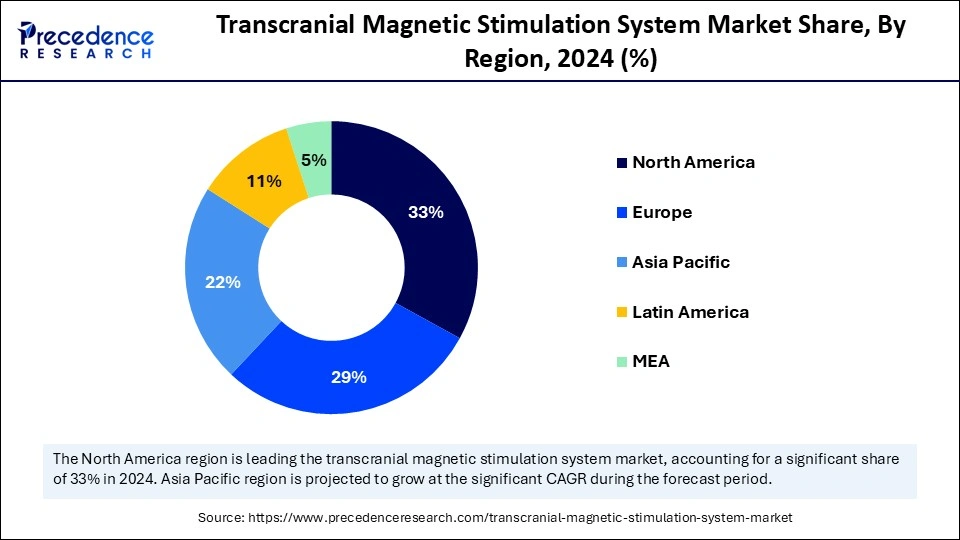
What are the major trends in the transcranial magnetic stimulation system market within Asia Pacific?
Asia Pacific is growing at a notable CAGR of 10.3% during the forecast period, propelled by expanding healthcare access, increasing awareness of neurological disorders, and rising investment in advanced medical technologies across emerging economies. This region presents significant untapped potential for market expansion. Government initiatives aimed at improving mental health infrastructure also stimulate market growth. Moreover, the growing middle-class population with greater disposable income supports increased adoption of TMS therapies. These factors collectively create a fertile environment for rapid market development
What opportunities exist in the European transcranial magnetic stimulation system market?
Europe is a significantly growing area. The increasing mental health awareness, rising neurological disease burden, and expanding access to non-invasive brain stimulation therapies open new avenues in Europe. Several European countries, including Germany, the UK, and France, are actively investing in mental health initiatives and advanced neuromodulation treatments. The region benefits from a growing number of research collaborations and clinical trials aimed at expanding the therapeutic use of TMS across multiple indications. Furthermore, favorable regulatory frameworks and the rising adoption of TMS in outpatient settings are driving its clinical integration. With strong public healthcare systems and rising demand for innovative, drug-free therapies, Europe is poised to play a significant role in the global expansion of TMS systems market.
Market Overview
The transcranial magnetic stimulation system market is experiencing steady growth, driven by a growing need for non-invasive drug-free therapies the growing prevalence of depression that is resistant to treatment and heightened awareness of mental health issues.
Technological developments like image-guided stimulation and customized protocols are improving the efficacy and precision of treatment. Access to TMS is also becoming better in important areas thanks to regulatory approvals and growing insurance coverage. The TMS market is anticipated to see increased clinical adoption and geographic expansion as studies continue to confirm its effectiveness for ailments like OCD, PTSD, and chronic pain.
Transcranial Magnetic Stimulation System MarketGrowth Factors
- Rising Cases of Mental Health Disorders: Increased prevalence of depression and anxiety is driving the demand for alternative treatments where conventional medications fall short.
- Non-Invasive Preference: Growing demand for drug-free, non-invasive treatments is rising as they offer fewer side effects, making them more appealing to patients.
- Technological Advancements: Improvements in TMS technology enhance accuracy, precision, and outcomes. Newer systems allow personalized protocols and real-time brain targeting.
- Better Reimbursement: Supportive insurance coverage improves treatment affordability and encourages wider adoption.
- Expanding Applications: Use of TMS is rising for conditions beyond depression like OCD and PTSD. Ongoing clinical trials are broadening their therapeutic scope.
Market Scope
| Report Coverage | Details |
| Market Size by 2034 | USD 3.33 Billion |
| Market Size in 2025 | USD 1.51 Billion |
| Market Size in 2024 | USD 1.38 Billion |
| Market Growth Rate from 2025 to 2034 | CAGR of 9.22% |
| Dominating Region | North America |
| Fastest Growing Region | Asia Pacific |
| Base Year | 2024 |
| Forecast Period | 2025 to 2034 |
| Segments Covered | Type, Application, Age Group, and Region |
| Regions Covered | North America, Europe, Asia-Pacific, Latin America, and Middle East & Africa |
Market Dynamics
Drivers
Growing Demand for Non-Invasive, Drug-Free Therapies
TMS offers a non-invasive, non-pharmacological alternative for individuals who are resistant to antidepressants or prefer drug-free treatments due to concerns about side effects. The appeal of drug-free therapy is particularly strong among younger populations and those seeking holistic approaches to mental wellness, contributing to TMS's rising popularity. This shift aligns with a broader consumer preference for personalized and low-risk mental health treatments. In addition, the rising approvals for new TSM treatments propel the growth of the transcranial magnetic stimulation system market.
- In March 2025, Magstim announced that its Horizon 3.0 and Inspire TMS systems received FDA clearance for adolescent use, emphasizing the importance of non-drug interventions in youth mental health.
(Source: https://www.globenewswire.com)
Expanding Infrastructure for Mental Health Disorders
With the growing burden of mental health disorders, governments and private health systems are expanding their telehealth offerings, building new clinics, and investing more in mental health services. Increasing the number of facilities with TMS systems is part of this infrastructure expansion, which is backed by funding for mental health and policy-level initiatives, particularly in high-burden areas. Collaborations between mental health providers and TMS device manufacturers are accelerating geographic outreach.
Restraints
Lack of Trained Professionals and Standardization
Specialized training is needed to operate TMS systems, and a lack of qualified personnel is impeding the growth of the transcranial magnetic stimulation system market, particularly in developing nations. Furthermore, there is variation in clinical results due to the lack of widely recognized treatment protocols and guidelines. The extensive clinical use of TMS systems is restricted by this discrepancy, which also has an impact on patient trust and healthcare provider adoption. This also makes cross-clinic standardization difficult, affecting large-scale research and comparative studies.
Mixed Clinical Efficacy and Delayed Onset
Although TMS works for a lot of patients, not everyone experiences the same outcomes. Some people might not react at all or might not get better for weeks. Some patients and doctors are put off by this variability as well as the idea that it works more slowly than pharmaceutical treatments. In addition to making clinical decisions more difficult, the absence of biomarkers to predict treatment response restricts personalized therapy.
Opportunities
Acceptance of Advanced TMS System
The rising demand and acceptance of advanced TMS systems create immense opportunities in the transcranial magnetic stimulation system market. The acceptance of non-invasive treatments and advanced TMS systems is increasing as a result of high awareness of mental health issues. Accessibility and uptake of TMS therapy are increasing as a result of its inclusion in public and private insurance coverage in developed countries. The growing number of certified clinics and qualified professionals is also boosting confidence in the technology and assisting in its acceptance as a common treatment option. As insurance coverage improves in developing regions, affordability barriers are expected to decline rapidly.
Expanding Applications and Technological Convergence
Beyond depression and OCD, TMS is being explored for a wider range of neurological and psychiatric disorders, such as autism spectrum disorders, chronic pain, and substance abuse. This expansion is supported by early-stage trials and exploratory FDA pathways. The integration of AI, neuroimaging, and adaptive stimulation technologies is creating opportunities to tailor treatment protocols for diverse conditions. These advancements not only enhance clinical precision but also open new commercial pathways for specialized TMS devices and platforms.
Type Insights
Why did repetitive transcranial magnetic stimulation segment dominated the market in 2024?
The repetitive transcranial magnetic stimulation segment dominated the transcranial magnetic stimulation system market with the largest revenue share of 40% in 2024. This is mainly attributed to the increased number of patients with depression that are resistant to drug-based treatments. This prompted the need for non-invasive, drug-free therapies like TMS. Strong clinical validation, increased insurance coverage, and continuous improvements that enhance treatment results are further bolstering the segment. The rising awareness of the benefits of repetitive TMS is boosting its adoption in hospitals and specialty mental health clinics, supporting segmental growth.
The deep transcranial magnetic stimulation segment is projected to grow at the fastest CAGR of 9.64% in the coming years, driven by its improved accuracy in stimulating deeper brain regions. Beyond the scope of traditional TMS, this improved capability enables better treatment of complex neuropsychiatric conditions. Improvements in coil design are improving the efficiency of dTMS. The rising preference for more accurate and efficient treatments is driving the growth of the segment.
Application Insights
What made Alzheimer's disease the dominant segment?
The Alzheimer's disease segment dominated the transcranial magnetic stimulation system market by holding more than 43% in 2024. This is mainly due to the increased burden of the disease and the limited availability of pharmacological options to treat neurodegenerative diseases. TMS treatments gained immense popularity to improve Alzheimer's patients' cognitive abilities. Investments in associated therapeutic technologies are being driven by governments and healthcare organizations' greater emphasis on dementia care. The rising number of clinical trials aimed at Alzheimer's disease is expected to maintain the growth of the segment. Additionally, the need for efficient Alzheimer's treatments is rising due to the world's aging population
The depression segment is expected to grow at the fastest CAGR in the upcoming period, driven by a growing patient base looking for alternative therapies and increased awareness of depression that is resistant to treatment. The demand for non-invasive TMS treatments is rising quickly because they provide a promising alternative for patients who don't respond well to medication. This expansion is further fueled by growing mental health awareness initiatives and a decline in the stigma associated with psychiatric illnesses. Furthermore, enhancements to TMS protocols that target depression specifically improve patient adherence and treatment outcomes. The rising number of patients with depression that are resistant to drug-based treatments and the growing desire for non-invasive, drug-free therapies are bolstering the segmental growth.
Age Group Insights
Which age group dominated the transcranial magnetic stimulation system market in 2024?
The adults segment dominated the market with the contributing more than 60% in 2024. This is mainly due to the increased prevalence of mental health disorders among adults. There is an increased patient demand for alternative therapies and increased awareness of depression that is resistant to treatment. For patients who do not respond well to medication, non-invasive TMS treatments present a promising alternative propelling the market's explosive growth in this area. This growth is also being driven by a decrease in the stigma associated with psychiatric disorders and an increase in mental health awareness campaigns. Furthermore, enhancements to TMS protocols that target depression specifically improve patient adherence and treatment outcomes. Depression is the most dynamic application segment because of these factors combined.
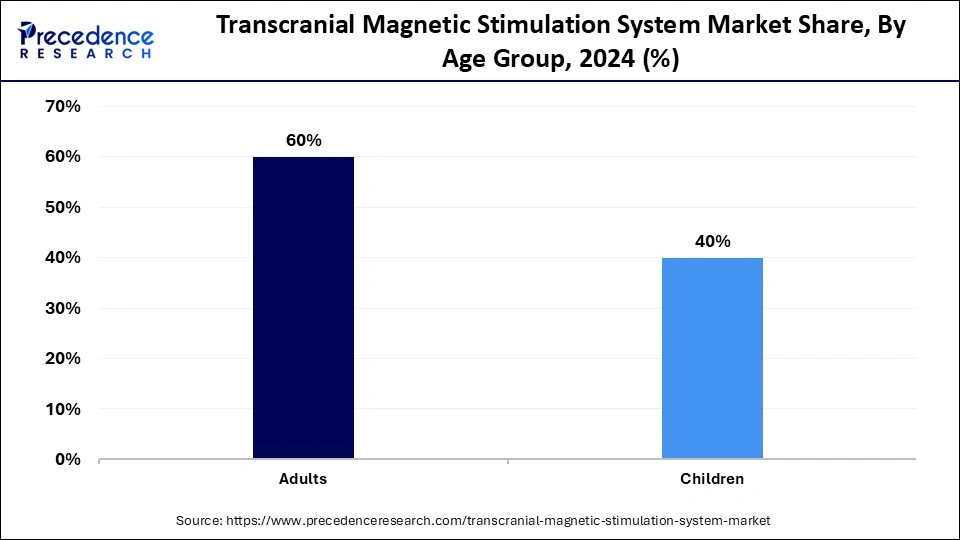
The children segment is expected to grow at a significant CAGR of 9.52% in the coming years, driven by emerging research demonstrating the safety and efficacy of TMS in younger patients with conditions such as depression, OCD, and autism spectrum disorders. Expanding regulatory approvals and clinical trials are driving this rapid adoption. Parents and caregivers are increasingly seeking non-pharmaceutical treatment options, boosting demand in this segment. Specialized TMS devices designed for younger patients also contribute to faster market growth. This segment's growth reflects a broader trend toward early intervention in neuropsychiatric disorders.
Transcranial Magnetic Stimulation System MarketCompanies
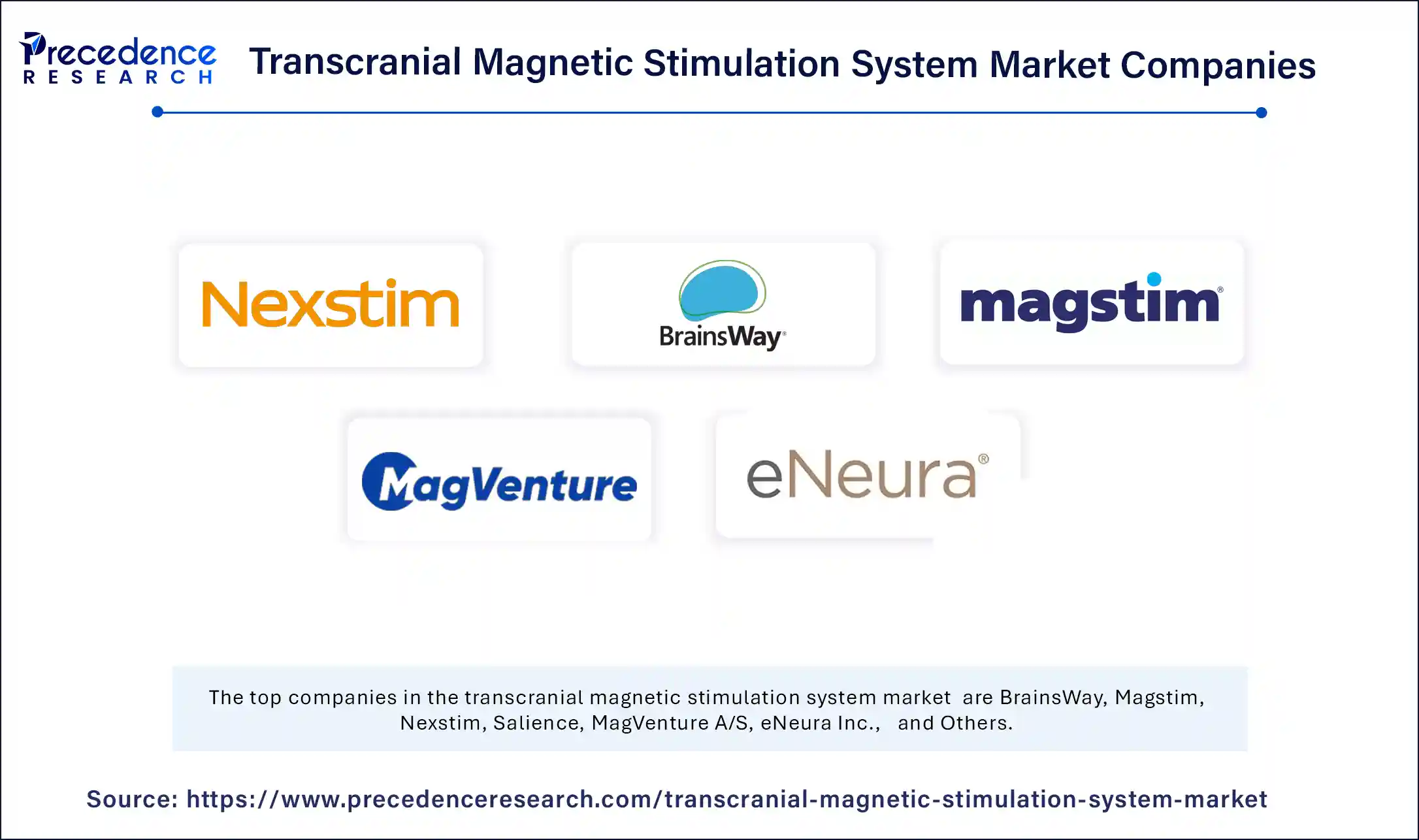
Recent Developments
- In January 2025, MagVenture announced that its MagVenture Pain Therapy, a non-invasive TMS solution for chronic pain relief, received FDA clearance. This marks the company's expansion beyond psychiatric applications into the chronic pain management market. The therapy leverages MagVenture's expertise in magnetic stimulation to offer a novel approach to pain treatment.
(Source: https://magventure.com) - In November 2024, Magstim has been awarded FDA clearance for the Horizon Inspire System, continuing to provide physicians, nurse practitioners, clinicians, and researchers with next-generation transcranial magnetic stimulation technology to treat patients with MDD, OCD and Anxious Depression.
(Source: https://www.globenewswire.com)
Segments Covered in the Report
By Type
- Deep Transcranial Magnetic Stimulation
- Repetitive Transcranial Magnetic Stimulation
- Others
By Application
- Alzheimer's Disease
- Depression
- Parkinson's Disease
- Epilepsy
- Others
By Age Group
- Adults
- Children
By Region
- North America
- Europe
- Asia Pacific
- Latin America
- Middle East and Africa
For inquiries regarding discounts, bulk purchases, or customization requests, please contact us at sales@precedenceresearch.com
Frequently Asked Questions
Ask For Sample
No cookie-cutter, only authentic analysis – take the 1st step to become a Precedence Research client